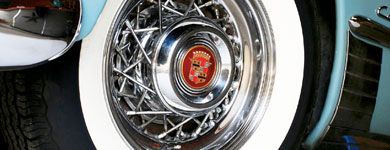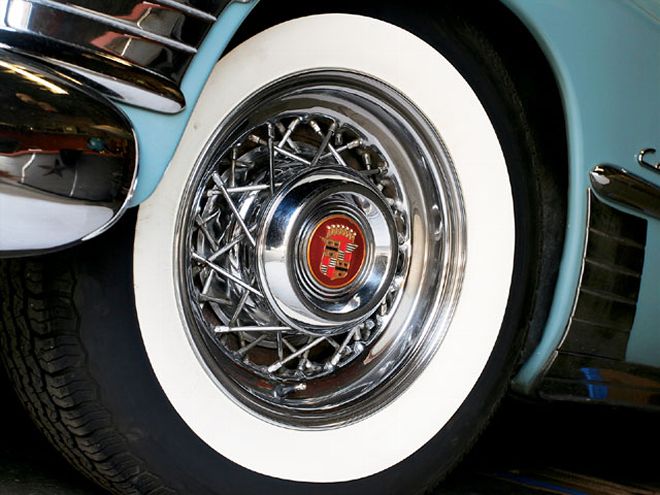

The wire wheel has to be the greatest relic of the automotive world. Sure, it's superior to the wood-spoked carryovers from the prior generation's motorized carriages, but the disc-type wheel that superseded the wire pretty much stole its thunder. And that happened in the first quarter of the last century. Anymore, the wire is heavy, maintenance intensive, and wildly outdated. Still, it's a perennial favorite.
And for good reason, really; on the right car, nothing beats the proper wire wheel. This isn't just opinion, either. As history shows, each generation "discovers" the mystique in the glint of the spokes. When that happens, the wire evolves to suit the times. As a result of this evolution by revolution, we have a pretty vast array of vintage wire wheels from which to choose-and all of 'em have appeared on at least one hot rod or custom over the years. Since popularity goes hand in hand with value, old wires are the old-car world's gold standard.
Second only to wear, the worst thing against old wires is the relative lack of reliable knowledge. Even that has its reasons; it seems anybody who attempts to define these wheels meets certain doom-or at least scorn from those who seem to know better. Ron Ceridono certainly found out in his Nov. '01 "Shop Manual" entry regarding early Ford wires. A little oversight regarding some adapter rings they require when used on later hubs initiated a fecal tempest that took until the Apr. '02 issue to clean up.
This time, we armed ourselves for bear. Among the resources we mined was Jimmy McLean. If you have roots in this industry, the name should sound familiar. It's because Jimmy's dad, Gary, established his mark several times in the hot rod, custom car, lowrider, and luxury car market with several wire wheel brands including, among others, McLean, Sharp, and his latest, Rally America.
As it turns out, you learn a lot about old wires while scouting for your ol' man's wheel shop. Though Jimmy's just barely old enough to buy a beer, his knowledge far exceeds his years. Combine his observations with those of Mike Stallings, the chief over at Wheel Vintiques, and you've got a body of knowledge and experience that's pretty hard to dispute.
Going into this, it seemed pretty simple to categorize the whole body of popular wire wheels, but as we learned, there are more details than you'd think. It's for that reason that we broke this work into two pieces. With this installment, we'll catalog the finer points of the OEM and specific-fit accessory wheels. Next month, we'll dig into the aftermarket.
V-8 Ford And Accessories
If photos taken before December 7, 1941, serve as any indication, the wheels for a proper hot roadster were designed for '32-35 Fords. Though the technically superior '40 wheel was available for two years prior to that date, the cars weren't yet old enough to populate boneyards in sufficient numbers to make their parts affordable.
Lowest on the totem are the factory Ford rollers and the 17- and 18-inch accessories. But, the kings of the hill were-and still are-the 16-inch accessories. Due to their size, many assume they were intended for '35s, but it's been said that the majority of these wheels were intended to "upgrade" '32-34 Fords to 16-inch tires. Though anecdotal, it makes sense; due to the auto industry's almost universal adoption to that diameter by the late '30s, there existed a vast array of tire sizes and styles.
With those 16s, there was also the promise of better ride and traction: Overall tire diameter being equal, a tire with a smaller wheel diameter has a wider tread and fatter sidewall. If that really was a popular objective, it may explain the existence of the rare 15-inch Kelsey Hayes wheel, a non-standard diameter for the era that would've used what was called at the time a balloon-type tire.
While the V-8-style wire's popularity waned after the war, those wheels made a pretty strong comeback in the late '60s and early '70s when renegades like Bo Jones, Bud Bryan, and Jim "Jake" Jacobs bolted them on their rolling calling cards. Using that era and the prewar period as examples, you could say the early wire wheel defined the early hot rod and street rod periods alike.
Kelsey Hayes' GM Wires
The year 1953 was a watershed year for GM's special-edition car releases. Both Cadillac and Buick finally got their El Dorado and Skylark specials that year. Most importantly, the bespoke spokes that adorned the cars in the Motorama shows appeared on the production models.
The wheels were part of each car's design, but both brands offered them to customers whose taste outpaced their ability to buy the actual cars. At $325 a set in their day (nearly $3,000 in today's dollars), these wheels were precious; however, they were far from rare. While the Eldo's popularity was somewhat limited, the Skylark's wheel appeared on just about everything.
Though the company knew better by the time, Kelsey built these wheels to the old-standard 40-spoke two-cross pattern. While that design made a wheel more than strong enough to support a 2,500-pound car that rarely exceeded 50 mph, it was woefully inadequate on turnpike barges that easily doubled that weight. With hardly a strength margin to speak of, they require thoughtful care and handling.
Motor Wheel Corp.Chrysler/Imperial/Packard/Hudson
With its distinctive dog-bone center cap, nothing looks quite like the wire wheel made for the '53-56 Chrysler Corp. cars. Despite their popularity, they're relatively misunderstood.
First, despite enduring folklore, they were made by Motor Wheel Corp. and not Kelsey Hayes. Second, they weren't exclusive to Chrysler. According to Jimmy at Rally America, Motor Wheel offered no less than 10 different variations of the design to the OEM world for factory options (Packard and Hudson, for one example) and to the aftermarket world as parts-store accessories (early Thunderbird and Corvette for another). Though the wheels differ in several ways, including bolt pattern, width, and wheel offset, the caps are interchangeable due to a universal register.
The Chrysler wire also has a little-known stepbrother of sorts: the wheel made for the Dodge, Plymouth, and later DeSoto and Packard. They have similar hubs and take the same cap, but there's no mistaking the two. Whereas all of the spokes in most wire wheels terminate in the rim's drop center-or well-the construction usually limits wheel-offset options. To give the Dodge's wheel the positive offset it needed to fit under the fenders of the smaller car, Motor Wheel terminated the face spokes in the outermost wheel flange, or felloe as it's often called.
Kelsey Hayes Thunderbird Sports RoadsterWhen Ford tooled up for its special-edition '62 and '63 Thunderbird roadster, it patronized one of its long-standing vendors, Kelsey Hayes. Just as Motor Wheel did for the smaller Dodge, Kelsey lip-laced these wheels to fit them under the narrower T-bird.
Speaking of Motor Wheel, there are a few important things to understand about T-bird wheels. The Kelsey wheels that Ford sold on the Sports Roadster and in its parts departments from 1962 onward were different from those available for the earlier T-birds. According to Jimmy, those earlier wheels were made by Motor Wheel. They were never a factory-authorized Ford part. The official Ford wheels also had a 14-inch diameter.
Vintage Wire Safety And LimitationsWe take wheels for granted nowadays. We can bolt the most exotic ones to a car and pretty much forget about 'em and risk nothing more than aesthetics. A wire isn't quite so forgiving. If neglected, they can actually fail in a fairly short time-hence one of the reasons the OEMs abandoned them nearly a century ago. Imagine what the passing of time has done to most.
It's for those reasons that wheel builders like Mike Stallings and Jimmy McLean emphasize a high level of scrutiny when shopping for vintage wire wheels. "Thirty years ago when these things were all over the place, it wasn't so bad, but you should see the stuff they're dragging out of wrecking yards and riverbeds lately-it's scary," Mike observed.
For example, the slightest corrosion can spell doom to a wire wheel if it's in the right place. "Pay attention to the dimpled area of the rim," Mike instructed. "If it's bad, spokes can pull right through." Jimmy said to check the area immediately around the lug holes on the Ford V-8-style wheels and their accessory counterparts; if the wheels have been run without the registration lugs or adapter rings, the holes are likely worn or cracked. He also instructed us to pay attention to hubs on the '53 Cadillac wheels, as the transition from the wheel mounting face and the hub itself is very sharp and often cracks.
There's also this enduring notion that radial tires are a bad idea on wheels intended for bias-ply tires. While he didn't categorically dismiss it, Mike did caution against it for one main reason: driving style.
"Nowadays, we're used to putting a 6,000-pound car into a corner at 80 miles per hour," he noted. Whereas a bias-ply tire will slide, a radial "will transfer a lot more lateral load, and an early wheel might not be able to handle that."
On the other hand, the gentler rim radiuses and safety beads, among other things on modern rims, have made wheels stronger, Mike said. How much stronger? In 1955, when these wheels were new and strong, they were expected to handle a 900- to 1,000-pound side load; however, "Today we're building wheels to make sure they'll handle 1,400 to 1,500."